Press releases
-
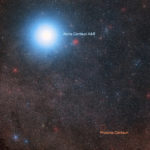
Sky view of Proxima Centauri and its companion stars alpha Centauri A and B. “An Earth-like Stellar Wind for Proxima Centauri c”, featured in a Science Update of the Harvard-Smithsonian Center for Astrophysics in Cambridge/MA, USA, 2020. In this work we show through numerical simulations that an exoplanet around our nearest neighbor, the small stars Proxima Centauri, is embedded in a stellar wind environment very much like our own Earth.
Publication: An Earth-like Stellar Wind Environment for Proxima Centauri c, Julián D. Alvarado-Gómez, Jeremy J. Drake, Cecilia Garraffo Ofer Cohen, Katja Poppenhaeger, Rakesh K. Yadav, and Sofia P. Moschou, ApJLett 902, L9, 2020.
-

Artist’s impression of the extrasolar planet system around the star V1298 Tau. Credit: AIP/J. Fohlmeister “Four newborn exoplanets get cooked by their sun”, featured in press release of the Leibniz Institute for Astrophysics Potsdam (AIP), 2020. In this work, we observe the very young4-planet system around the active star V1298 Tau in X-rays and characterize how much of the exoplanetary atmospheres could get cooked away by the intense X-ray radiation of the star. The final fate of the four planets depends crucially upon the timescale in which the star will spin down; a fast spin down will leave the planetary atmospheres mostly intact, while a late spin-down (and therefore a long time in which the star is spinning quickly and being X-ray active) will cause the atmospheres of several exoplanets to evaporate completely.
Publication: X-ray irradiation and evaporation of the four young planets around V1298 Tau, Poppenhaeger, K.; Ketzer, L.; Mallonn, M., Monthly Notices of the Royal Astronomical Society, May 2020.
-
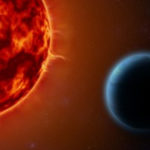
Artist’s impression of the hot Jupiter (right) and its cool host star. Credit: AIP/Kristin Riebe “Chemical element potassium detected in an exoplanet atmosphere”, featured in press release of the Leibniz Institute for Astrophysics Potsdam (AIP), 2019. Here PhD student Engin Keles from my research group succeeds in detecting potassium in an exoplanet’s atmosphere, using high-resolution spectra for the first time. This was also featured in a press release by the Large Binocular Telescope: “link”
Publication: The potassium absorption on HD189733b and HD209458b, Keles, E.; Mallonn, M.; von Essen, C.; Carroll, T. A.; Alexoudi, X.; Pino, L.; Ilyin, I.; Poppenhäger, K.; Kitzmann, D.; Nascimbeni, V.; Turner, J. D.; Strassmeier, K. G., Monthly Notices of the Royal Astronomical Society: Letters, Volume 489, Issue 1, p.L37-L41 (2019).
-
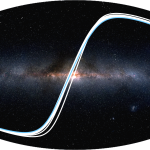
Image credit: 2MASS / A. Mellinger / R. Wells. “Are we being watched?”, featured in press release of the Royal Astronomical Society, 2017. Here my PhD student Rob Wells presents the locations in the universe from which an observer could discover the solar system planets through transit observations. Interestingly, several already discovered exoplanets are located in these Transit Visibility Zones, however no currently known habitable ones.
Wells, R.; Poppenhaeger, K.; Watson, C. A.; Heller, R., “Transit Visibility Zones of the Solar System Planets”, Monthly Notices of the Royal Astronomical Society, Volume 473, Issue 1, p.345-354 (2018).
-
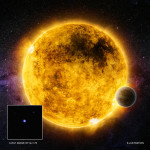
Image credit: NASA/CXC/R. Booth/M. Weiss “X-rays Reveal Temperament of Possible Planet-Hosting Stars”, featured in press release by NASA, 2017. Here my PhD student Rachel Booth presents a new age-activity relationship for old cool stars. We found that the activity decreases much more quickly than thought before for stellar ages older than a gigayear. This is good news for the habitability of exoplanets, but also brings up some new questions about how stekkar spin-down works.
Booth, R. S.; Poppenhaeger, K.; Watson, C. A.; Silva Aguirre, V.; Wolk, S. J.: “An Improved Age-Activity Relationship for Cool Stars older than a Gigayear”, accepted for publication by Monthly Notices of the Royal Astronomical Society (2017).
-

Image credit University of Warwick/M. Garlick “Monster planet discovery challenges planet formation theories”, featured in press release of Queen’s University Belfast and the University of Warwick, 2017. Here the Next Generation Transit Survey collaboration in which I take part reports on the discovery of a large planet (a Hot Jupiter) around a very low-mass star. This configuration was thought to be extremely rare, and it is not quite clear how such planets are actually formed in such a system. Some interesting work ahead of us after this discovery!
Bayliss, Daniel and 42 co-authors including Poppenhaeger, Katja, “NGTS-1b: a hot Jupiter transiting an M-dwarf”, Monthly Notices of the Royal Astronomical Society, Volume 475, Issue 4, p.4467-4475 (2018).
-

image credit: NASA/Spitzer “Twinkle, Twinkle, New-Born Star”, featured in Science Update of the Harvard-Smithsonian Center for Astrophysics, December 2014. This one is about our findings about young stars and their planet-forming disks, published in Günther et al. (2014). It turns out that practically all disk-bearing stars are variable in brightness, especially as shown in this study in the mid-infrared, where disks had previously assumed to be rather quiescent. However, our work shows that the mid-disk probed by our observations is a highly dynamic and variable place.
Günther, H. M.; Cody, A. M.; Covey, K. R.; Hillenbrand, L. A.; Plavchan, P.; Poppenhaeger, K.; Rebull, L. M.; Stauffer, J. R.; Wolk, S. J.; Allen, L.; Bayo, A.; Gutermuth, R. A.; Hora, J. L.; Meng, H. Y. A.; Morales-Calderón, M.; Parks, J. R.; Song, Inseok: “YSOVAR: Mid-infrared Variability in the Star-forming Region Lynds 1688”, The Astronomical Journal, Volume 148, Issue 6, article id. 122, 20 pp. (2014).
-
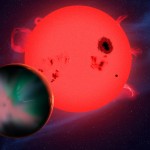
image credit: CfA/Aguilar “Harsh space weather may doom potential life on red-dwarf planets”, featured in press release at the 224th meeting of the American Astronomical Society, June 2014. This one is about our work on atmospheres of planets in habitable zones around M dwarfs. We find that the magnetic shielding of exoplanets is likely not strong enough to protect the exoplanetary atmosphere from being eroded by the stellar wind over time, meaning that many old exoplanets in M dwarf systems may have lost large parts of their atmosphere.
Cohen, O.; Drake, J. J.; Glocer, A.; Garraffo, C.; Poppenhaeger, K.; Bell, J. M.; Ridley, A. J.; Gombosi, T. I.: “Magnetospheric Structure and Atmospheric Joule Heating of Habitable Planets Orbiting M-dwarf Stars”, The Astrophysical Journal, Volume 790, Issue 1, article id. 57, 13 pp. (2014).
-

image credit: Poppenhaeger “Big planets could alter star rotation”, featured in Nature Research Highlights May 2014. This one is about our work on stellar rotation in exoplanet systems. We find for several systems that the close-in exoplanet has likely altered the evolution of the stellar rotation by depositing angular momentum from the planetary orbit into the stellar spin.
Poppenhaeger, K.; Wolk, S. J.: “Indications for an influence of hot Jupiters on the rotation and activity of their host stars”, Astronomy & Astrophysics, Volume 565, id.L1, 5 pp. (2014).
-

image credit: NASA/CXC/K. Poppenhaeger “NASA’s Chandra Sees Eclipsing Planet in X-rays for First Time”, featured in NASA press release July 2013. This one is about our observations leading to the first detection of an exoplanetary atmosphere in the X-ray band. We find that the exoplanetary atmosphere of this Hot Jupiter is extended and dense enough to be X-ray opaque out to altitudes of 1.7 optical radii.
Poppenhaeger, K.; Schmitt, J. H. M. M.; Wolk, S. J.: “Transit Observations of the Hot Jupiter HD 189733b at X-Ray Wavelengths”, The Astrophysical Journal, Volume 773, Issue 1, article id. 62, 16 pp. (2013).
-
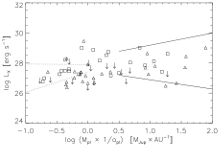
image credit: K. Poppenhaeger “Astronomy: No planetary X-ray pull”, featured in Nature Research Highlights July 2010. This one is about our research on the coronal emission of planet-hosting stars in the solar neighborhood. We find that in the full sample of the observed planet-hosting stars there is no significant X-ray enhancement of the star that can be traced back to a gradual star-planet interaction effect.
Poppenhaeger, K.; Robrade, J.; Schmitt, J. H. M. M.: “Coronal properties of planet-bearing stars”, Astronomy and Astrophysics, Volume 515, id.A98, 9 pp. (2010).